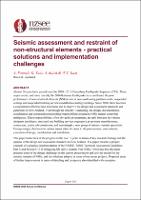Seismic assessment and restraint of non-structural element - practical solutions and implementation challenges

Download
Date
2020-04-22Authors
Pourali, Atefeh
Tata, Kaiwaan
Baird, Andrew
Kam, Weng Yuen
Metadata
Show full item recordAbstract
Almost 10 years have passed since the 2010 - 2011 Canterbury Earthquake Sequence (CES). These major events, and more recently the 2016 Kaikoura Earthquake have confirmed the poor performance of non-structural elements (NSEs) such as non-loadbearing partition walls, suspended ceilings and suspended building services installed in existing buildings. Since 2010, there has been a concentrated effort to raise awareness and to improve the design and assessment standards and guidelines in New Zealand. Even though the industry is maturing, the design, documentation, coordination and construction monitoring responsibilities related to NSEs remain somewhat ambiguous. These responsibilities, often driven by procurement, are split between the various designers (architects, structural and building services engineers), proprietary manufacturers, contractors, trades sub-contractors, and increasingly a new group of seismic restraint specialists. Unsurprisingly, this leads to various issues when it comes to the procurement, cost estimate, execution of design, coordination and installation.
This paper looks back at the progress in the past 10 years in terms of key research findings and the updates of the design and assessment standards in New Zealand. The paper presents a project example of a practical implementation of the NZSEE / MBIE Technical Assessment Guidelines Part A and Section C10 in mitigating life safety hazards from NSEs. Following this, the paper presents some of the design challenges in the current procurement and delivery model for the seismic restraint of NSEs, and the solutions adopted in some of our recent projects. Proposed areas of further improvement in terms of detailing and design are also identified with examples.
